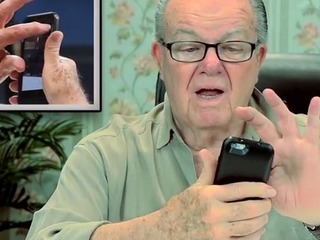Perseverance: From running out of money to an IPO - StubHub comes back strong
In the post-Covid drive for live events, ticket platforms are jumping at the opportune market time
Read more...
Smartphone growth has stalled recently, with shipments declining for the first time ever at the beginning of last year, and expectations for growth slowing considerably.
A big part of the problem is oversaturation. Basically, so many people have smartphones now that the number of new customers is dwindling as people hold onto them longer. The solution, then, is to find new customers, people who have been late to the party in jumping on this bandwagon.
According to a new study out from Pew on Wednesday, the solution could be some from an interesting place: old people.
A survey of 3,015 U.S. adults found that smartphone usage among those aged 65 and older has more than tripled in the last five years, growing from just 11 percent to 42 percent in that time. That's a faster pace than the overall adult population, which has doubled from 35 percent to 72 percent.
When broken down further, not surprisingly, the older the person the less likely they are to own a smartphone.
Those aged 65 to 69 have seen the highest adoption, with 59 percent now owning a phone, and just about 50 percent of the 70 to 74 year olds do as well. It drops precipitously from there, with only 31 percent of 75 to 79 year olds, and just 17 of those over 80.
This growth could represent a big opportunity for the smartphone market. There are currently 46 million Americans who are aged 65 and older, meaning that there's still 91 million potential users that are just now starting to adopt this technology. According to the Population Reference Bureau, those numbers are going to grow quickly: the number of Americans ages 65 and older is projected to more than double to over 98 million by 2060, and the 65-and-older age group’s share of the total population will rise to nearly 24 percent from 15 percent.
While older people are embracing smartphones, tablets and e-readers are not seeing the same numbers among that population. Only 32 percent own a tablet and just 19 percent have an e-reader. Tablets follow the same trajectory as the smartphone, losing percentage with age. Interestingly, though, e-readers are most popular with those aged 70 to 74, with 23 percent, compared to 21 percent of those 65 to 69.
Overall, this change is very likely a positive development for these older people, who will now be more connected to the world. Currently, 67 percent of seniors have an Internet connect, and more than half, 58 percent, of them say that technology has had a mostly positive impact on society.
Those who won't benefit from this? Their younger relatives, as over a third of older internet users say they have little to no confidence in their ability to use electronic devices to perform online tasks, while 73 percent of seniors say that they need at least some help using their new devices. That means that its the rest of us who are going to get called upon to teach them.
As someone who has spent an incredible amount of time trying to teach an old person how to use their phone, I only say: good luck, you're going to need it.
(Image source: huffingtonpost.co)
In the post-Covid drive for live events, ticket platforms are jumping at the opportune market time
Read more...EveryCure will leverage BioLogicAI, BioPhy’s predictive AI engine, to assess drug-disease matches
Read more...The contract will make it easier for state agencies to evaluate and implement Fusion's technology
Read more...